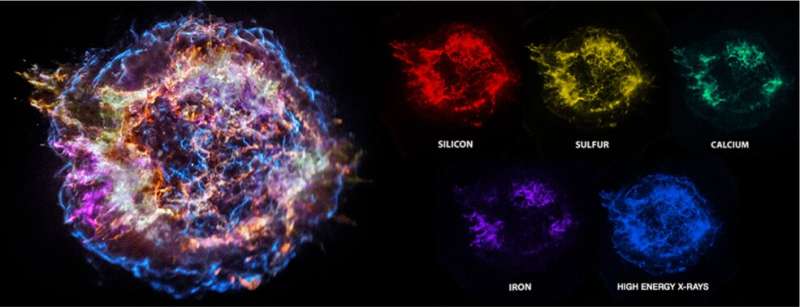NASA rocket using 'astronomical forensics' will study exploded star

A NASA-funded sounding rocket mission will observe the remnants of an exploded star, uncovering new details about the eruption event while testing X-ray detector technologies for future missions. The High-Resolution Microcalorimeter X-ray Imaging (Micro-X) experiment will launch Aug. 21 from the White Sands Missile Range in New Mexico.
The mission's target of study is some 11,000 light-years away from Earth, off the edge of the W-shaped constellation known as Cassiopeia. There, a massive bubble of radiant material known as Cassiopeia A, or Cas A for short, marks the site of a brilliant stellar death.
The eruption's light first reached Earth around 1680, though there are no historical reports of it at the time. It wasn't discovered until 1948, and since then Cas A has become one of the most well-studied objects in the night sky.
Like scattered shrapnel, material from the explosion spread across some 13 light-years of space. "The sun and its 14 closest stars would all fit inside the Cas A supernova remnant," said Enectali Figueroa-Feliciano, a professor of physics and astronomy at Northwestern University in Illinois and principal investigator for the Micro-X mission.
To observe Cas A, Micro-X will launch aboard a sounding rocket. Sounding rockets make brief, 15-minute forays into space before falling back to the ground. Once in space, Micro-X will have about five minutes to observe Cas A, focusing on its X-ray light. Cosmic X-rays are absorbed by our atmosphere and so are only detectable from space.
"The X-ray energy spectrum is like a fingerprint revealing the composition, history, and state of the gas and ejecta from the explosion," Figueroa-Feliciano said. "Like forensic evidence, it gives us clues of how the death of the star came about."
Though many missions have observed Cas A, the new detectors on Micro-X will see it like never before. "Micro-X has a resolution about 50 times higher than existing orbiting observatories," Figueroa-Feliciano said.
Sounding rockets are how many cutting-edge technologies make their first trips to space. One of Micro-X's goals is to test the new detector technologies for future missions that may use them, like the ESA-led (European Space Agency) ATHENA mission.
Micro-X first launched July 23, 2018, but the attitude control system on the rocket malfunctioned. The detectors worked, but it was unable to point accurately at Cas A during its observation period.
For the upcoming re-flight, Figueroa-Feliciano and his team have increased Micro-X's resolution two-fold. "This factor of two is very significant," Figueroa-Feliciano said. "Our science depends on measuring the energy of X-rays with exquisite resolution."
If all goes as planned, Micro-X will once again descend safely to the ground for recovery. "This project has potential to do interesting science over several flights. We're hoping to get it back, refurbish it, and fly it again," Figueroa-Feliciano said.
Provided by NASA's Goddard Space Flight Center



















